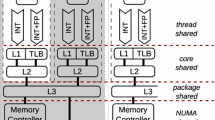Abstract
This paper focuses on the algorithmic aspects for the hardware/software (HW/SW) partitioning which searches a reasonable composition of hardware and software components which not only satisfies the constraint of hardware area but also optimizes the execution time. The computational model is extended so that all possible types of communications can be taken into account for the HW/SW partitioning. Also, a new dynamic programming algorithm is proposed on the basis of the computational model, in which source data, rather than speedup in previous work, of basic scheduling blocks are directly utilized to calculate the optimal solution. The proposed algorithm runs in O(n ⋅ A) for n code fragments and the available hardware area A. Simulation results show that the proposed algorithm solves the HW/SW partitioning without increase in running time, compared with the algorithm cited in the literature.
Similar content being viewed by others
References
Niemann R, Marwedel P. Hardware/software partitioning using integer programming. In Proc. the IEEE/ACM European Design Automation Conference (EDAC), Paris, France, March 1996, pp.473–479.
Gupta R, Micheli G D. Hardware-software cosynthesis for digital systems. IEEE Design and Test of Computers, 1993, 10(3): 29–41.
Gupta R K, Coelho C, De Micheli G. Synthesis and simulation of digital systems containing interacting hardware and software components. In Proc. the 29th ACM/IEEE Design Automation Conference, Los Alamitos, CA, USA, June 1992, pp.225–230.
Ernst R, Henkel J, Benner T. Hardware-software co-synthesis for micro-controllers. IEEE Design and Test of Computer, 1993, 10(4): 64–75.
Vahid F, Gajski D D, Gong J. A binary-constraint search algorithm for minimizing hardware during hardware/software partitioning. In Proc. IEEE/ACM European Design Automation Conference (EDAC), Paris, France, February 1994, pp.214–219.
Vahid F, Gajski D D. Clustering for improved system-level functional partitioning. In Proc. the 8th International Symposium on System Synthesis, Cannes, France, September 1995, pp.28–33.
Quan G, Hu X, Greenwood G W. Preference-driven hierarchical hardware/software partitioning. In Proc. IEEE International Conference on Computer Design, Austin, TX, USA, October 1999, pp.652–657.
Srinivasan V, Radhakrishnan S, Vemuri R. Hardware software partitioning with integrated hardware design space exploration. In Proc. DATE’98, Paris, France, February 1998, pp.28–35.
Niemann R, Marwedel P. An algorithm for hardware/software partitioning using mixed integer linear programming. Design Automation for Embedded Systems, Special Issue: Partitioning Methods for Embedded Systems, 1997, 2(2): 165–193.
Weinhardt M. Integer programming for partitioning in software oriented codesign. Lecture Notes in Computer Science, 1995, 975: 227–234.
Peng Z, Kuchcinski K. An algorithm for partitioning of application specific system. In Proc. IEEE/ACM European Design Automation Conference (EDAC), Paris, February 1993, pp.316–321.
Henkel J, Ernst R. An approach to automated hardware/software partitioning using a flexible granularity that is driven by high-level estimation techniques. IEEE Trans. VLSI Sys., 2001, 9(2): 273–289.
Eles P, Peng Z, Kuchcinski K, Dobolt A. System level hardware/software partitioning based on simulated annealing and tabu search. Design Automation for Embedded Systems, 1997, 2(1): 5–32.
Karam S C, Ranga V. Hardware-software partitioning and pipelined scheduling of transformative applications. IEEE Transactions on Very Large Scale Integration (VLSI) Systems, 2002, 10(3): 193–208.
Madsen J, Grode J, Knudsen P V, Petersen M E, Haxthausen A. LYCOS: The Lyngby co-synthesis system. Design Automation for Embedded Systems, 1997, 2: 195–235.
Wu Jigang, Srikanthan T. Low-complex dynamic programming algorithm for hardware/software partitioning. Information Processing Letters, 2006, 98: 41–46.
Edwards S A, Lavagno L, Lee E A et al. Design of embedded systems: Formal models validation, and synthesis. In Proc. the IEEE, 1997, 85(3): 366–390.
Vallejo M L, Lopez J C. On the hardware-software partitioning problem: System modeling and partitioning techniques. ACM Transactions on Design Automation of Electronic Systems, 2003, 8(3): 269–297.
Pisinger D. Algorithms for knapsack problems [Dissertation]. University of Copenhagen, 1995.
Arato P, Mann Z A, Orban A. Algorithmic aspects of hardware/software partitioning. ACM Transactions on Design Automation of Electronic Systems, 2005, 10(1): 136–156.
Author information
Authors and Affiliations
Corresponding author
Electronic supplementary material
Below is the link to the electronic supplementary material.
Rights and permissions
About this article
Cite this article
Wu, JG., Srikanthan, T. & Zou, GW. New Model and Algorithm for Hardware/Software Partitioning. J. Comput. Sci. Technol. 23, 644–651 (2008). https://doi.org/10.1007/s11390-008-9160-9
Received:
Revised:
Published:
Issue Date:
DOI: https://doi.org/10.1007/s11390-008-9160-9




